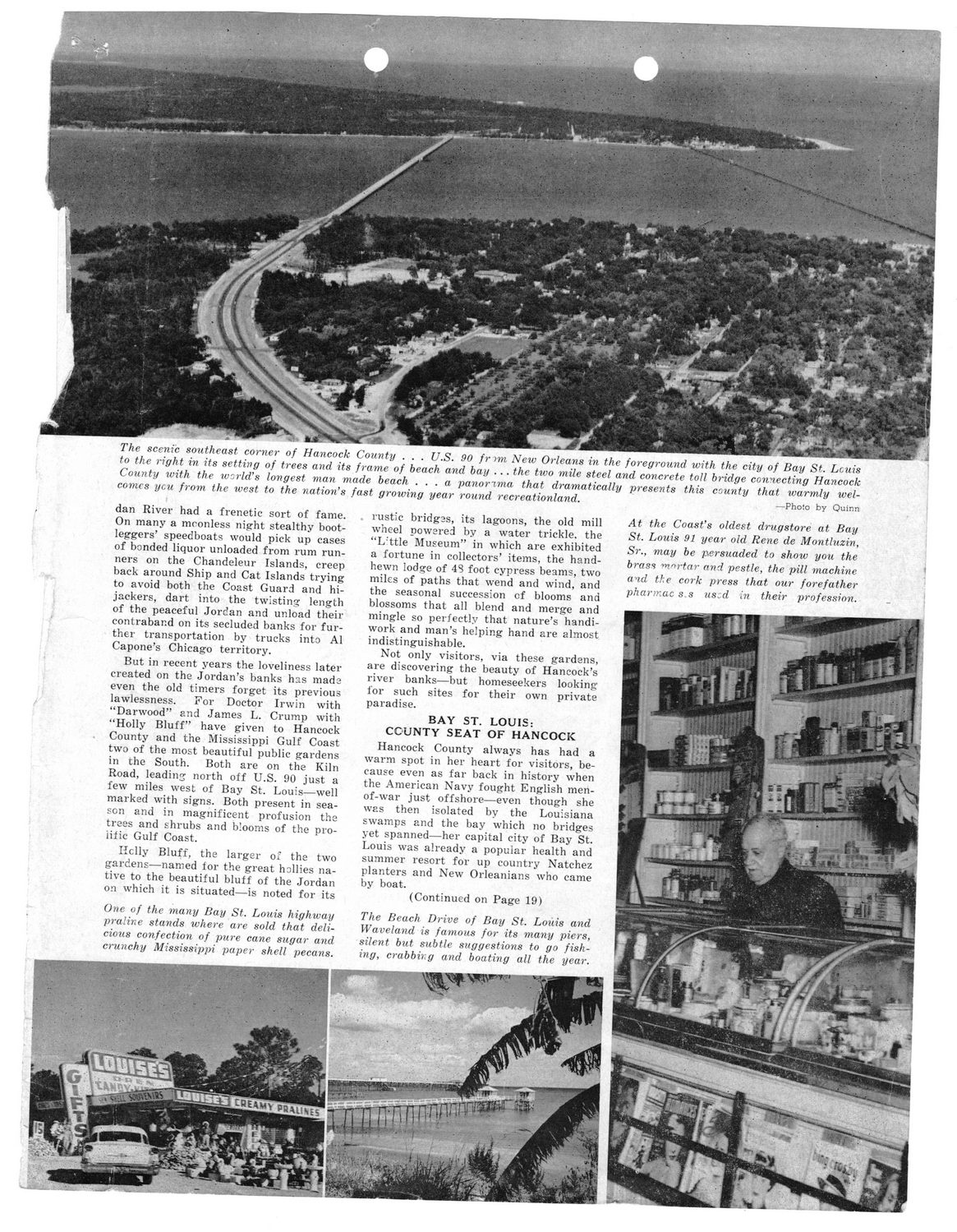This text was obtained via automated optical character recognition.
It has not been edited and may therefore contain several errors.
The scenic southeast corner of Hancock County . . . U.S. 90 frtm New Orleans in the foreground with the city of Bay St. Lcuis to the right in its setting of trees and its frame of beach and bay . . . the two mile steel and concrete toll bridge connecting Hancock County with the world’s longest man made beach . . . a panorima that dramatically presents this county that warmly welcomes ycu from the west to the nation’s fast growing year round recreationland. dan River had a frenetic sort of fame. On many a mconless night stealthy bootleggers’ speedboats would pick up cases of bonded liquor unloaded from rum runners on the Chandeleur Islands, creep back around Ship and Cat Islands trying to avoid both the Coast Guard and hijackers, dart into the twisting length of the peaceful Jordan and unload their contraband on its secluded banks for further transportation by trucks into A1 Capone’s Chicago territory. But in recent years the loveliness later created on the Jordan’s banks has mada even the old timers forget its previous lawlessness. For Doctor Irwin with “Darwood” and James L. Crump with “Holly Bluff” have given to Hancock County and the Mississippi Gulf Coast two of the most beautiful public gardens in the South. Both are on the Kiln Road, leading north off U.S. 90 just a few miles west of Bay St. Louis—well marked with signs. Both present in season and in magnificent profusion ths trees and shrubs and blooms of the prolific Gulf Coast. Ilclly Bluff, the larger of the two gardens—named for the great hollies native to the beautiful bluff of the Jordan on which it is situated—is noted for its One of the many Bay St. Louis highway praline stands where are sold that delicious confection of pure cane sugar and crunchy Mississippi paper shell pecans. rustic bridgss, its lagoons, the old mill wheel powered by a water trickle, the “L'ttle Museum” in which are exhibited a fortune in collectors’ items, the hand-hewn lodge of 48 foot cypress beams, two miles of paths that wend and wind, and the seasonal succession cf blooms and blossoms that all blend and merge and mingle so perfectly that nature’s handiwork and man’s helping hand are almost indistinguishable. Not only visitors, via these gardens, are discovering the beauty of Hancock’s river banks—but homeseekers looking for such sites for their own private paradise. BAY ST. LOUIS: COUNTY SEAT OF HANCOCK Hancock County always has had a warm spot in her heart for visitors, because even as far back in history when the American Navy fought English men-of-war just offshore—even though she was then isolated by the Louisiana swamps and the bay which no bridges yet spanned—her capital city of Bay St. Louis was already a popular health and summer resort for up country Natchez planters and New Orleanians who came by boat. (Continued on Page 19) The Beach Drive of Bay St. Louis and Waveland is famous for its many piers, silent but subtle suggestions to go fishing, crabbing and boating all the year. —Photo by Quinn At the Coast’s oldest drugstore at Bay St. Louis 91 year old Rene de Montluzin, Sr., may be persuaded to show you the brass •mnrt.ar and pestle, the pill machine a'ld the cork press that our forefather pharmac s.s us:d in their profession.

BSL 1950 To 1969 Hancock-County-Western-Gateway-(03)